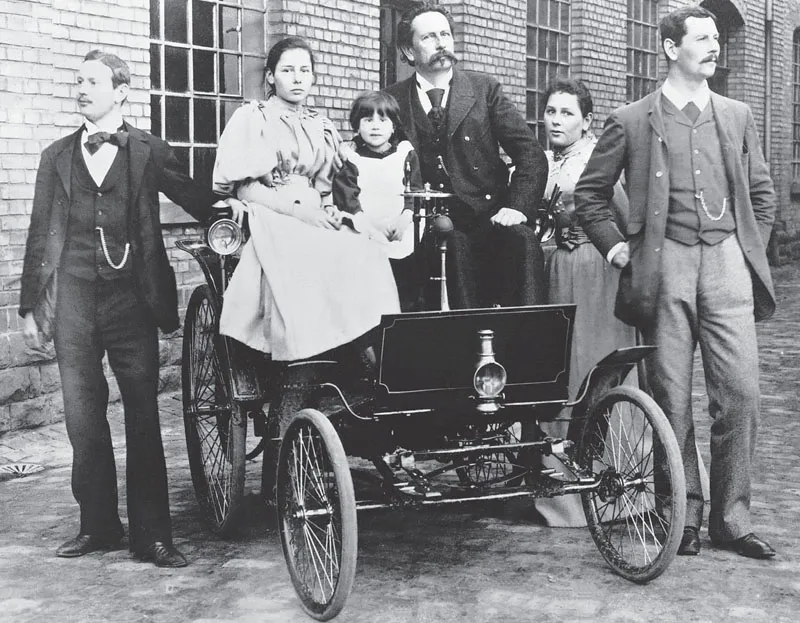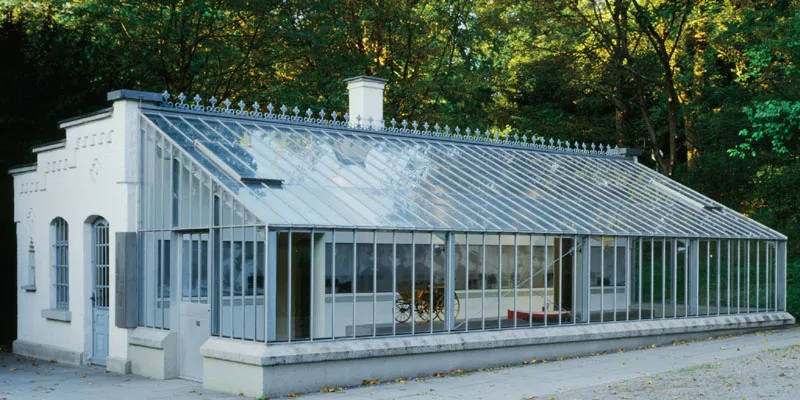![]()
CHAPTER ONE
ORIGINS – BUILDING THE FASTEST, THE MOST AND THE BEST
Mercedes-Benz was built on the principles of two men who went to great lengths to construct only the best. And, being very early pioneers of automobile technology, they both had moments of self-doubt and an irresistible urge continuously to refine and improve their work. Carl Benz tested his first vehicle only at night so that any hiccups would not gain public attention. Gottlieb Daimler disguised his early innovations so that if there was a problem, others might speculate they were from other inventors.
Carl Benz
Carl Benz (who was given the name Karl but preferred to spell it with a ‘C’) had a tough upbringing. He was born in Karlsruhe, Germany, on 25 November 1844, to a railroad engineer father who died when he was young, and a mother who worked hard to ensure that Benz’s poor background would not hinder his education. His mother did not want him to embark on a career in trains, but the mechanical side of the business caught the young man’s attention. After attending technical college, he went on to work as a draughtsman for his hometown locomotive works.
By 1871 Benz had started his own machine shop and turned his attention to motor vehicles. While his business fortunes were not the greatest in the beginning, he took a significant step forward with his marriage in 1872. His new wife Bertha Ringer was not only savvy enough to utilize her wedding dowry to rid Carl of an unreliable business partner, but would also provide the catalyst that Benz needed to make progress.
As he built up his fledgling business, Benz decided he needed to create a grand product that the public would find popular. He put his efforts into a developing a two-stroke engine and had spent years trying to get the motor working, without success. Finally, on New Year’s Eve 1879, Bertha persuaded him to go over to the machine shop to give the motor another try. The couple saw in the new year with the exhaust note from the two-stroke motor roaring to life for the first time.
On 1 October 1883, Benz created Benz & Cie at his home in Mannheim, and within a year, it was turning a profit as an engine company. Benz was also working on a four-stroke motor that would run in a more refined manner than his two-stroke engine, with which he had now achieved good reliability. Now he finally had the pieces to begin developing a vehicle for the road. Within about a year, Benz had built a 580-lb three-wheeled vehicle with a one-cylinder, four-stroke 954cc motor that produced 0.75bhp.
Benz began testing his new vehicle. On its first run, it did not make it far within the courtyard of the machine shop before needing repair. Subsequent tests would achieve more, but the vehicle still never left the confines of the machine shop’s grounds. In January 1886, after more refinements, Benz was granted Patent 37 435 for his first vehicle.
Even with the patent, Benz was still shy about his motor car. All of his testing on the public roads around Mannheim was performed at night so that any breakdowns would not become fodder for the town gossips. He had built a second car at this point and, although he could get all the way around the city without incident, Benz could not resist tinkering with his invention. Even at these early stages, Carl Benz seemed to be living up to the future slogan of Mercedes-Benz: ‘The Best or Nothing.’
By 1886 Bertha Benz was much more convinced about the quality of her husband’s car than he was, and she wanted to find a way to prove it. She had a trip scheduled to see her mother 50 miles away in Pforzheim. Rather than take the train as planned, Bertha and the eldest Benz sons awoke before dawn. They pushed the vehicle out of the workshop and down the road, until it was far enough away from the house that the motor would not wake Benz, and then they set off. She had at least left him a note explaining where the precious vehicle was!
Bertha was resourceful enough to make a few minor repairs on the road, and she and her sons arrived in Pforzheim by nightfall with no major incident. While this may have been the first case in history of a stolen car, Bertha should certainly get the credit for the first long-distance journey in a Benz. More importantly, she gave her husband the proof he needed in order to feel confident in his motor cars.
On 29 January 1886 Benz received German patent no. 37 435 on his motorized vehicle.
The Benz family with a 3.5bhp Benz Comfortable in 1894 (left to right): son Richard, daughters Thilde and Ellen, Carl Benz, daughter Klara and son Eugen.
Gottlieb Daimler
Gottlieb Daimler was born 50 miles away from and ten years before Carl Benz. The son of a family of Stuttgart bakers, Daimler had a more comfortable upbringing than Benz. Still, it was a series of good mentors and scholarships that gave Gottlieb Daimler the opportunity of a proper education in engineering.
The difference in age meant that Benz and Daimler were not quite at the same stage in their careers as they were both finding their way to the internal combustion engine. The two men did work at the same locomotive firm in Karlsruhe within a few years of each other, but, while Daimler had a managing director position, Benz was still of an age for an entry-level position.
Shortly after completing his engineering education at Stuttgart Polytechnikum in 1860, Daimler would travel Europe learning about the machines of the Industrial Revolution. He returned home to Germany, where he took up a job managing the Bruderhaus Reutlingen near Stuttgart. According to Beverly Rae Kimes, in her book The Star and the Laurel, the Bruderhaus was ‘part orphanage, part vocational school, part engineering complex … the idea of the Lutheran theologian Gustav Werner and an ingenious religious answer to Marxism’.
Overseeing a workforce of orphans was not going to be a rewarding long-term career for Daimler, but it did introduce him to a star pupil, Wilhelm Maybach. Daimler still believed in a demand for a vehicle that was more personal than the locomotive, and was also sure that steam was not the power of the future. It was a much better fit for him when he joined the Gasmotoren-Fabrik Deutz company as technical manager in 1872. With Maybach in tow as chief designer, Daimler began working on producing internal combustion engines in the company started by Nikolaus Otto, father of the four-stroke engine.
After working for Deutz for a decade, Daimler was out. He wanted to make engines more mobile, and so he and Maybach set to work creating a smaller, lighter four-stroke motor. By 1883 they had a petrol-powered four-stroke that weighed less than 100lb (45.5kg) in an era when the Otto motors weighed as much as 750lb (340kg).
Having developed the engine, Daimler continued to refine it. He installed it on a bicycle, and had his sons run tests of the vehicle, which had effectively become a motorcycle. Daimler and Maybach also installed a new motor in a boat. Just like Benz, Daimler was careful not to let the public in on his testing. Unlike Benz, Daimler would run his boat during the daytime, but he employed decoy electrical terminals near the engine bay so that passengers might assume it was battery powered. Daimler also differed from Benz in that he saw a use for his engine not just in motor cars, but also for all transportation on land and water, and in the air.
Still, a motor vehicle was a priority and something that had not yet been accomplished. By 1886, around the time when Bertha Benz stole her husband’s car in order to prove its reliability, Daimler had had a carriage built by W. Wimpff & Sohn. Daimler said it was a birthday present for his wife, but in fact his plan was to attach his 1.5bhp motor to the structure to create the world’s first four-wheeled automobile. Daimler and Benz were now entering the car business at around the same time.
Daimler’s workshop, which he set up at his home in Stuttgart after leaving Deutz.
Daimler’s first motorboat on the Neckar River in 1886 (with Daimler and Maybach just right of the motor box).
Gottlieb Daimler formed Daimler-Motoren-Gesellschaft (DMG) on 28 November 1890. Once speed laws in Germany were relaxed, DMG would grow to produce some of the most powerful cars of the time. Carl Benz was also doing well; his company would develop into the largest car manufacturer in the world, with production exceeding 600 vehicles at the turn of the century. Between the two men, the vehicles represented significant manufacturing precision and speed.
The era of the motor car had begun, but for one of its pioneers it was the end of his road. Gottlieb Daimler was still part of DMG when he died, on 6 March 1900. There is no record of Carl Benz and Gottlieb Daimler ever formally meeting. After all, at the time of Daimler’s death, neither man could have known what the future was for their two companies, and surely neither could have predicted the amazing accomplishments that came with the union.
Gottlieb Daimler and Wilhelm Maybach’s high-speed four-stroke engine with hot-tube ignition.
Duelling Performance and Practicality
Mutton chops and a safari helmet might not seem like a recipe for sales success, but Emil Jellinek was DMG’s best customer at the turn of the century. A successful businessman from Vienna with an office in Nice, he liked speed and rubbed shoulders with all the right people.
Jellinek was first attracted to the brand when he noticed that Daimler’s company built the motors in most of the major race winners. He had purchased a 6bhp belt-driven car in 1897, but found it too slow. He would continue to demand cars with more power. As the factory kept abiding by his requests, Jellinek continued to order more cars that he would sell in France.
As the power ratings kept going up, Jellinek became a more important force on the race circui...







